Tensorflow¶
[1]:
%matplotlib inline
[2]:
import warnings
warnings.simplefilter('ignore', RuntimeWarning)
[3]:
import matplotlib.pyplot as plt
import pandas as pd
import numpy as np
import seaborn as sns
[4]:
from sklearn.datasets import fetch_california_housing
from sklearn.model_selection import train_test_split
from sklearn.preprocessing import StandardScaler
[5]:
import tensorflow as tf
[6]:
import tensorflow_probability as tfp
tfd = tfp.distributions
Working with tensors¶
Almost exactly like numpy arrays.
[7]:
tf.constant([1., 2., 3.])
[7]:
<tf.Tensor: shape=(3,), dtype=float32, numpy=array([1., 2., 3.], dtype=float32)>
[8]:
x = tf.Variable([[1.,2.,3.], [4.,5.,6.]])
[9]:
x.shape
[9]:
TensorShape([2, 3])
[10]:
x.dtype
[10]:
tf.float32
Indexing¶
[12]:
x[:, :2]
[12]:
<tf.Tensor: shape=(2, 2), dtype=float32, numpy=
array([[1., 2.],
[4., 5.]], dtype=float32)>
Assignment¶
[13]:
x[0,:].assign([3.,2.,1.])
[13]:
<tf.Variable 'UnreadVariable' shape=(2, 3) dtype=float32, numpy=
array([[3., 2., 1.],
[4., 5., 6.]], dtype=float32)>
[14]:
x
[14]:
<tf.Variable 'Variable:0' shape=(2, 3) dtype=float32, numpy=
array([[3., 2., 1.],
[4., 5., 6.]], dtype=float32)>
Reductions¶
[15]:
tf.reduce_mean(x, axis=0)
[15]:
<tf.Tensor: shape=(3,), dtype=float32, numpy=array([3.5, 3.5, 3.5], dtype=float32)>
[16]:
tf.reduce_sum(x, axis=1)
[16]:
<tf.Tensor: shape=(2,), dtype=float32, numpy=array([ 6., 15.], dtype=float32)>
Broadcasting¶
[17]:
x + 10
[17]:
<tf.Tensor: shape=(2, 3), dtype=float32, numpy=
array([[13., 12., 11.],
[14., 15., 16.]], dtype=float32)>
[18]:
x * 10
[18]:
<tf.Tensor: shape=(2, 3), dtype=float32, numpy=
array([[30., 20., 10.],
[40., 50., 60.]], dtype=float32)>
[19]:
x - tf.reduce_mean(x, axis=1)[:, tf.newaxis]
[19]:
<tf.Tensor: shape=(2, 3), dtype=float32, numpy=
array([[ 1., 0., -1.],
[-1., 0., 1.]], dtype=float32)>
Matrix operations¶
[20]:
x @ tf.transpose(x)
[20]:
<tf.Tensor: shape=(2, 2), dtype=float32, numpy=
array([[14., 28.],
[28., 77.]], dtype=float32)>
Ufuncs¶
[21]:
tf.exp(x)
[21]:
<tf.Tensor: shape=(2, 3), dtype=float32, numpy=
array([[ 20.085537 , 7.389056 , 2.7182817],
[ 54.59815 , 148.41316 , 403.4288 ]], dtype=float32)>
[22]:
tf.sqrt(x)
[22]:
<tf.Tensor: shape=(2, 3), dtype=float32, numpy=
array([[1.7320508, 1.4142135, 1. ],
[2. , 2.236068 , 2.4494898]], dtype=float32)>
Random numbers¶
[23]:
X = tf.random.normal(shape=(10,4))
y = tf.random.normal(shape=(10,1))
Linear algebra¶
[24]:
tf.linalg.lstsq(X, y)
[24]:
<tf.Tensor: shape=(4, 1), dtype=float32, numpy=
array([[ 0.02415883],
[ 0.17781891],
[-0.20745884],
[-0.30115527]], dtype=float32)>
Vectorization¶
[25]:
X = tf.random.normal(shape=(1000,10,4))
y = tf.random.normal(shape=(1000,10,1))
[26]:
tf.linalg.lstsq(X, y)
[26]:
<tf.Tensor: shape=(1000, 4, 1), dtype=float32, numpy=
array([[[ 0.19148365],
[-0.51689374],
[-0.17029501],
[ 0.484788 ]],
[[ 0.7028206 ],
[-0.15227778],
[ 0.6967405 ],
[-0.60269237]],
[[-0.25489303],
[ 0.20810236],
[ 0.88173383],
[ 0.28963062]],
...,
[[-0.15725346],
[ 0.49795693],
[ 0.13796304],
[-0.11143823]],
[[-0.00428388],
[ 0.6222656 ],
[ 0.02911544],
[-0.56122893]],
[[ 0.3179135 ],
[-0.41116422],
[-0.16914578],
[ 0.5184275 ]]], dtype=float32)>
Automatic differntiation¶
[27]:
def f(x,y):
return x**2 + 2*y**2 + 3*x*y
Gradient¶
[28]:
x, y = tf.Variable(1.0), tf.Variable(2.0)
[29]:
with tf.GradientTape() as tape:
z = f(x, y)
[30]:
tape.gradient(z, [x,y])
[30]:
[<tf.Tensor: shape=(), dtype=float32, numpy=8.0>,
<tf.Tensor: shape=(), dtype=float32, numpy=11.0>]
Hessian¶
[31]:
with tf.GradientTape(persistent=True) as H_tape:
with tf.GradientTape() as J_tape:
z = f(x, y)
Js = J_tape.gradient(z, [x,y])
Hs = [H_tape.gradient(J, [x,y]) for J in Js]
del H_tape
[32]:
np.array(Hs)
[32]:
array([[2., 3.],
[3., 4.]], dtype=float32)
Tensorflow proability¶
Distributions¶
[33]:
[str(x).split('.')[-1][:-2] for x in tfd.distribution.Distribution.__subclasses__()]
[33]:
['Autoregressive',
'BatchReshape',
'Bates',
'Bernoulli',
'Beta',
'Gamma',
'Binomial',
'BetaBinomial',
'JointDistribution',
'JointDistribution',
'_Cast',
'Blockwise',
'Categorical',
'Cauchy',
'Chi2',
'TransformedDistribution',
'LKJ',
'CholeskyLKJ',
'ContinuousBernoulli',
'_BaseDeterministic',
'_BaseDeterministic',
'Dirichlet',
'Multinomial',
'DirichletMultinomial',
'DoublesidedMaxwell',
'Empirical',
'FiniteDiscrete',
'GammaGamma',
'Normal',
'Sample',
'GaussianProcess',
'GeneralizedNormal',
'GeneralizedPareto',
'Geometric',
'Uniform',
'HalfCauchy',
'HalfNormal',
'StudentT',
'HalfStudentT',
'HiddenMarkovModel',
'Horseshoe',
'Independent',
'InverseGamma',
'InverseGaussian',
'Laplace',
'LinearGaussianStateSpaceModel',
'Logistic',
'Mixture',
'MixtureSameFamily',
'MultivariateStudentTLinearOperator',
'NegativeBinomial',
'OneHotCategorical',
'OrderedLogistic',
'Pareto',
'PERT',
'QuantizedDistribution',
'Poisson',
'_TensorCoercible',
'PixelCNN',
'PlackettLuce',
'PoissonLogNormalQuadratureCompound',
'SphericalUniform',
'VonMisesFisher',
'PowerSpherical',
'ProbitBernoulli',
'RelaxedBernoulli',
'ExpRelaxedOneHotCategorical',
'StudentTProcess',
'Triangular',
'TruncatedCauchy',
'TruncatedNormal',
'VonMises',
'WishartLinearOperator',
'Zipf',
'DeterministicEmpirical']
[34]:
dist = tfd.Normal(loc=100, scale=15)
[35]:
x = dist.sample((3,4))
x
[35]:
<tf.Tensor: shape=(3, 4), dtype=float32, numpy=
array([[ 90.82311 , 115.852325, 69.85233 , 111.310234],
[114.064575, 113.6998 , 104.08606 , 115.32353 ],
[ 98.11167 , 104.219315, 112.88289 , 106.38903 ]], dtype=float32)>
[36]:
n = 100
xs = dist.sample(n)
plt.hist(xs, density=True)
xp = tf.linspace(50., 150., 100)
plt.plot(xp, dist.prob(xp))
pass
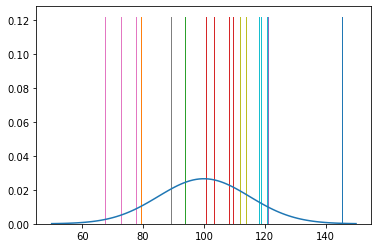
Broadcasting¶
[37]:
dist = tfd.Normal(loc=[3,4,5,6], scale=0.5)
[38]:
dist.sample(5)
[38]:
<tf.Tensor: shape=(5, 4), dtype=float32, numpy=
array([[3.4214985, 4.020046 , 5.4378996, 7.129439 ],
[2.4713418, 3.6216328, 5.1785645, 6.5690327],
[3.2009451, 3.6195786, 5.032829 , 5.546834 ],
[2.6353314, 3.8272653, 4.5734615, 6.2040973],
[3.0592232, 4.0541725, 4.9947314, 5.419991 ]], dtype=float32)>
[39]:
xp = tf.linspace(0., 9., 100)[:, tf.newaxis]
plt.plot(np.tile(xp, dist.batch_shape), dist.prob(xp))
pass
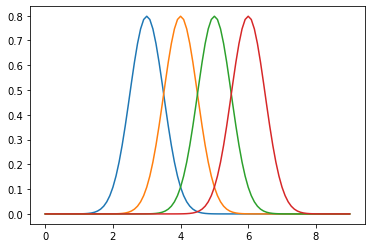
Mixtures¶
[40]:
gmm = tfd.MixtureSameFamily(
mixture_distribution=tfd.Categorical(
probs=[0.4, 0.1, 0.2, 0.3]
),
components_distribution=tfd.Normal(
loc=[3., 4., 5., 6.],
scale=[0.1, 0.5, 0.5, .1])
)
[41]:
n = 10000
xs = gmm.sample(n)
[42]:
sns.distplot(xs)
pass
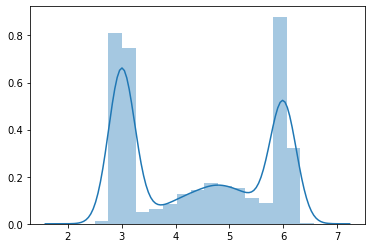
Transformations¶
[43]:
[x for x in dir(tfp.bijectors) if x[0].isupper()]
[43]:
['AbsoluteValue',
'Affine',
'AffineLinearOperator',
'AffineScalar',
'AutoregressiveNetwork',
'BatchNormalization',
'Bijector',
'Blockwise',
'Chain',
'CholeskyOuterProduct',
'CholeskyToInvCholesky',
'CorrelationCholesky',
'Cumsum',
'DiscreteCosineTransform',
'Exp',
'Expm1',
'FFJORD',
'FillScaleTriL',
'FillTriangular',
'FrechetCDF',
'GeneralizedExtremeValueCDF',
'GeneralizedPareto',
'GompertzCDF',
'GumbelCDF',
'Identity',
'Inline',
'Invert',
'IteratedSigmoidCentered',
'KumaraswamyCDF',
'LambertWTail',
'Log',
'Log1p',
'MaskedAutoregressiveFlow',
'MatrixInverseTriL',
'MatvecLU',
'MoyalCDF',
'NormalCDF',
'Ordered',
'Pad',
'Permute',
'PowerTransform',
'RationalQuadraticSpline',
'RealNVP',
'Reciprocal',
'Reshape',
'Scale',
'ScaleMatvecDiag',
'ScaleMatvecLU',
'ScaleMatvecLinearOperator',
'ScaleMatvecTriL',
'ScaleTriL',
'Shift',
'ShiftedGompertzCDF',
'Sigmoid',
'Sinh',
'SinhArcsinh',
'SoftClip',
'Softfloor',
'SoftmaxCentered',
'Softplus',
'Softsign',
'Split',
'Square',
'Tanh',
'TransformDiagonal',
'Transpose',
'WeibullCDF']
[44]:
lognormal = tfp.bijectors.Exp()(tfd.Normal(0, 0.5))
[45]:
xs = lognormal.sample(1000)
sns.distplot(xs)
xp = np.linspace(tf.reduce_min(xs), tf.reduce_max(xs), 100)
plt.plot(xp, tfd.LogNormal(loc=0, scale=0.5).prob(xp))
pass

Regression¶
[46]:
xs = tf.Variable([0., 1., 2., 5., 6., 8.])
ys = tf.sin(xs) + tfd.Normal(loc=0, scale=0.5).sample(xs.shape[0])
[47]:
xs.shape, ys.shape
[47]:
(TensorShape([6]), TensorShape([6]))
[48]:
xs.numpy()
[48]:
array([0., 1., 2., 5., 6., 8.], dtype=float32)
[49]:
ys.numpy()
[49]:
array([-0.21832775, 0.49554497, 1.124055 , -0.30666602, -0.6614609 ,
1.8780737 ], dtype=float32)
[50]:
xp = tf.linspace(-1., 9., 100)[:, None]
plt.scatter(xs.numpy(), ys.numpy())
plt.plot(xp, tf.sin(xp))
pass
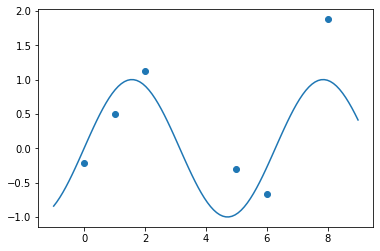
[51]:
kernel = tfp.math.psd_kernels.ExponentiatedQuadratic(length_scale=1.5)
reg = tfd.GaussianProcessRegressionModel(
kernel, xp[:, tf.newaxis], xs[:, tf.newaxis], ys
)
[52]:
ub, lb = reg.mean() + [2*reg.stddev(), -2*reg.stddev()]
plt.fill_between(np.ravel(xp), np.ravel(ub), np.ravel(lb), alpha=0.2)
plt.plot(xp, reg.mean(), c='red', linewidth=2)
plt.scatter(xs[:], ys[:], s=50, c='k')
pass
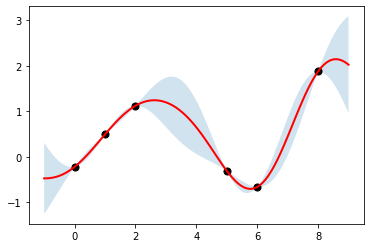
Tenssorflow Data¶
Tesnorflow provides a data API to allow it to work seamlessly with large data sets that may not fit into memory. This results inTesnorfolw Dataset (TFDS) objects that handle multi-threading, queuing, batching and pre-fetching.
You can think of TFDS as being a smart generator from data. Generally, you first create a TFDS from data using from_tensor_slices or from data in the file system or a relational database. Then you apply trasnforms to the data to process it, before handing it off to, say, a deep learning method.
Using from_tensor_slices¶
You can pass in a list, dict, numpy array, or Tensorflow tensor.
[53]:
x = np.arange(6)
ds = tf.data.Dataset.from_tensor_slices(x)
ds
[53]:
<TensorSliceDataset shapes: (), types: tf.int64>
[54]:
for item in ds.take(3):
print(item)
tf.Tensor(0, shape=(), dtype=int64)
tf.Tensor(1, shape=(), dtype=int64)
tf.Tensor(2, shape=(), dtype=int64)
Transformations¶
Once you have a TFDS, you can chain its transformation methods to process the data. We will cover functional programming next week, but most of this should be comprehensible even without a deep understanding of functional programming.
[55]:
ds = ds.map(lambda x: x**2).repeat(3)
[56]:
for item in ds.take(3):
print(item)
tf.Tensor(0, shape=(), dtype=int64)
tf.Tensor(1, shape=(), dtype=int64)
tf.Tensor(4, shape=(), dtype=int64)
[57]:
ds = ds.shuffle(buffer_size=4, seed=0).batch(5)
[58]:
for item in ds.take(3):
print(item)
tf.Tensor([ 0 9 4 0 25], shape=(5,), dtype=int64)
tf.Tensor([ 1 9 1 16 0], shape=(5,), dtype=int64)
tf.Tensor([16 4 1 16 4], shape=(5,), dtype=int64)
Prefetching is an optimization to preload data in parallel¶
[59]:
ds.prefetch(buffer_size=tf.data.experimental.AUTOTUNE)
[59]:
<PrefetchDataset shapes: (None,), types: tf.int64>
Reading from files¶
You can also read from CSV, text files or SQLite database and transform in the same way.
[60]:
ds = tf.data.experimental.CsvDataset(
'data/X_train_unscaled.csv',
record_defaults=[tf.float32]*10,
header=True
)
[61]:
for item in ds.take(1):
print(item)
(<tf.Tensor: shape=(), dtype=float32, numpy=1.0>, <tf.Tensor: shape=(), dtype=float32, numpy=1.0>, <tf.Tensor: shape=(), dtype=float32, numpy=0.0>, <tf.Tensor: shape=(), dtype=float32, numpy=52.0>, <tf.Tensor: shape=(), dtype=float32, numpy=0.0>, <tf.Tensor: shape=(), dtype=float32, numpy=0.0>, <tf.Tensor: shape=(), dtype=float32, numpy=30.5>, <tf.Tensor: shape=(), dtype=float32, numpy=1.0>, <tf.Tensor: shape=(), dtype=float32, numpy=0.0>, <tf.Tensor: shape=(), dtype=float32, numpy=0.0>)